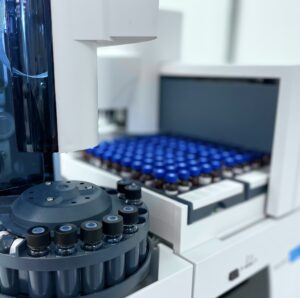 Due to the natural bioaccumulation properties of cannabis, the use of agricultural agents, such as pesticides, herbicides, fungicides, insecticides, and plant growth regulators, on this crop can be risky. Cultivators must take care to ensure that the pest remediation agents being utilized on this plant do not remain in the tissue after harvesting. Additionally, because cannabis is often extracted and concentrated down, the presence of agricultural agents, even in small quantities, can become a major problem after extraction due to the boiling point of these contaminants being similar to that of cannabinoids. While most cultivators would prefer to avoid the use of agricultural agents on their cannabis crops, this is sometimes unavoidable. As such, it is important to test all cannabis products being produced to ensure that these dangerous contaminants do not make their way to the consumers.
Due to the natural bioaccumulation properties of cannabis, the use of agricultural agents, such as pesticides, herbicides, fungicides, insecticides, and plant growth regulators, on this crop can be risky. Cultivators must take care to ensure that the pest remediation agents being utilized on this plant do not remain in the tissue after harvesting. Additionally, because cannabis is often extracted and concentrated down, the presence of agricultural agents, even in small quantities, can become a major problem after extraction due to the boiling point of these contaminants being similar to that of cannabinoids. While most cultivators would prefer to avoid the use of agricultural agents on their cannabis crops, this is sometimes unavoidable. As such, it is important to test all cannabis products being produced to ensure that these dangerous contaminants do not make their way to the consumers.
Bioaccumulation of Agricultural Agents in Cannabis
Similar to other agricultural products, cannabis is susceptible to being infested with a variety of insects, mites, and fungi, which can result in cultivators using agricultural agents to combat these issues. While many of these products are safe to use on crops, each of them have to be properly vetted by the EPA before use and due to the Schedule I drug status that cannabis currently possesses, no products have been officially approved for use on cannabis. As such, it is up to state regulators to make decisions regarding which agricultural agents can or cannot be used on the crop. Currently, many states have a list of approved and unapproved agricultural agents that may or may not be used during the cultivation process to combat pest infestation. Additionally, states have established regulatory limits for the pesticides, fungicides, insecticides, herbicides, and plant growth regulators to help ensure consumer safety and prevent dangerous agricultural agents from making it to the consumer at harmful levels.
As mentioned previously, one of the battles that cannabis cultivators and producers face when growing this plant is that it is a natural bioaccumulator and phytoremediator. As such, cannabis frequently allows products that have been used during cultivation to be uptaken into the tissues of the plant. When this occurs, dangerous agricultural agents can make their way to the consumer. The other problem that producers face as a result of cannabis being a bioaccumulator occurs when cannabinoids are extracted from the plant to make other products. This extraction occurs through various different techniques and most of the commonly used ones involve heating the flower up to a temperature that allows the cannabinoids to boil off and be separated. While this process is great for separating and concentrating the cannabinoids, it also concentrates any agricultural agents that may be present since these compounds tend to have boiling points similar to that of the cannabinoids being isolated. Therefore, producers can run into issues where their flower products may not contain dangerous amounts of agricultural agents, while the concentrated product does. As such, it is important for producers to understand the inherent risks associated with using agricultural agents that result directly from the plant’s ability to accumulate chemicals indiscriminately.
Health Risks of Agricultural Agent Consumption
As a result of incomprehensive testing regulations, uneducated producers/cultivators, and inexperienced laboratories, many legal cannabis products containing agricultural agents make it to market in both medical and adult-use states. Accurate testing for this class of contaminants is a necessary part of ensuring consumer safety. While there has been very little data gathered regarding the long-term effects of inhaled agricultural agents, such as pesticides, insecticides, and fungicides, through cannabis consumption, there is extensive research regarding the toxicity of these compounds. As such, it is important for laboratories to accurately identify and quantify these contaminants. Since the research is limited, there are sometimes complaints that the regulatory limits set forth for agricultural agents are much lower than where they should be, however, until more information is available regarding the impacts of inhaling these compounds, regulatory agencies are choosing to err on the side of caution.
Current research on the toxicity of agricultural agents, some of which are utilized during cannabis cultivation, suggest that health risks associated include everything from skin irritation to the development of cancer. To help viewers better understand the impact of agricultural agent consumption, we have provided information on some of the potential health risks associated with some of the most commonly detected agricultural agents in cannabis products.
- Myclobutanil – Acute exposure and consumption of this fungicide can lead to skin irritation. Additionally, research suggests that long term exposure can negatively impact reproductive organs, cause issues with steroid homeostasis, and lead to liver disease.
- Pyrethrins – This class of insecticides has been shown to cause headaches, nausea, dizziness, and in some cases convulsions or loss of consciousness when someone is exposed to the compounds at high levels.
- Spinetoram – This insecticide has been shown to have identical toxicity to Spinosad. Based on animal studies, it is believed that exposure to these compounds can lead to anemia, have negative immune responses, and may cause chronic inflammation.
Accurate Cannabis Testing to Ensure Consumer Safety
Seeing the associated health risks of agricultural agent exposure puts even more emphasis on the need for accurate safety testing. States like Florida, California, and Oregon have put together extensive testing panels that include upwards of 50 different agricultural agents, including pesticides, insecticides, fungicides, and plant growth regulators, to help ensure that dangerous contaminants are not making their way to the market. However, without accurate testing that is reliable, reproducible, and legally defensible, consumer safety cannot be guaranteed.

Modern Canna realizes the importance of this emerging threat to public health and performs all agricultural agent testing using liquid chromatography with tandem mass spectrometry (LC-MS/MS) and gas chromatography with tandem mass spectrometry (GC-MS/MS) to ensure the most accurate identification and quantification of these compounds. Based on the chemical composition of some of the compounds included in the testing panel for Florida’s medical cannabis program, our laboratory has opted to detect some of the compounds using GC-MS/MS versus the traditional LC-MS/MS to ensure that the laboratory can detect the compounds at the appropriate limits. The compounds analyzed by GC-MS/MS include chlorfenapyr, chlordane, captan, methyl parathion, and pentachloronitrobenzene.
In addition to testing all final product matrices including flower, derivatives, and edibles, our laboratory is also able to offer agricultural agent testing on input materials to help ensure that producers are not unknowingly adding contaminants to their products. To learn more about our testing services, please reach out to us today!


